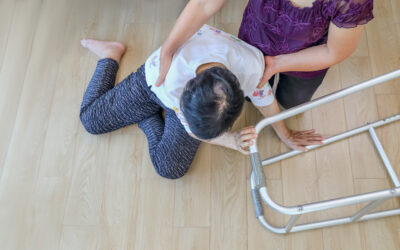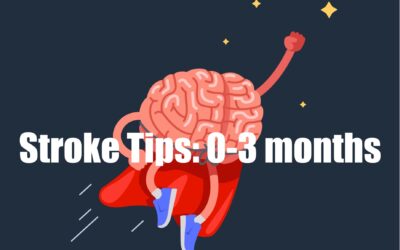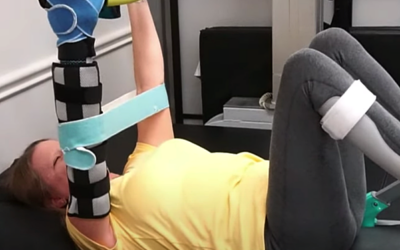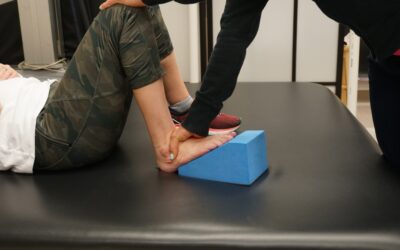HIIT for Stroke Recovery
Boost brain rewiring, improve movement, and speed recovery with short bursts of exercise.
If you’ve been on your stroke recovery journey for a while, you’ve probably heard the word neuroplasticity. Neuroplasticity is how your brain forms new connections so you can relearn skills like walking, talking, and using your hands again.
Important facts about neuroplasticity:
- It happens throughout your life, not just in the first 18 months after injury.
- Everyone with a neurological injury has the potential to improve.
- Progress isn’t just about repetition, the brain needs the right environment to rewire effectively.
What Happens in Your Brain During a Stroke?
A stroke happens when blood flow to part of your brain is blocked, or when a blood vessel in your brain bursts. This causes a sudden chaotic event inside your brain:
- Some brain cells (neurons) get damaged or die because they aren’t getting enough oxygen and nutrients.
- Other neurons around the damaged area go offline or stop working properly.
- The whole area becomes unstable and disorganized for a while.
This chaos actually primes your brain for neuroplasticity, meaning it becomes ready to rewire itself and make new connections to take over lost functions. That’s why getting into rehab as soon as possible is so important because it helps your brain take advantage of this window to start healing.
The Brain Chemicals That Make Neuroplasticity Possible
Three main “signaling molecules” help your brain form new connections:
- BDNF (Brain-Derived Neurotrophic Factor) – Supports neuron growth and survival.
- VEGF (Vascular Endothelial Growth Factor) – Promotes new blood vessel growth in the brain.
- Lactate – Acts as a backup fuel source for brain energy.
Why they matter:
- People with lower levels of these molecules have a higher risk of stroke, heart disease, and diabetes.
- After a stroke, these levels are often reduced.
- Raising them can improve brain rewiring and possibly lower the risk of another stroke.
So how do you increase these brain-boosting chemicals?
Why High-Intensity Interval Training (HIIT) Could Be a Game-Changer
Researchers studied 8 groups of stroke patients who did High-Intensity Interval Training (HIIT). They found:
- HIIT raised important brain chemicals like BDNF, which helps the brain heal
- It also increased VEGF and lactate, which improve blood flow and give the brain energy
- HIIT worked better at raising these chemicals than moderate exercise
Why does this matter?
Surprisingly, just doing repetitive exercises or task-specific training doesn’t raise these chemicals enough. What research shows is that high-intensity interval training (HIIT), which means short bursts of really hard exercise followed by rest, can boost them a lot.
HIIT is different from just “moving more”. It pushes your body hard enough to release brain-boosting chemicals that help your brain recover and improve movement.
What Does This Mean For You?
If you’re recovering from a stroke and feeling stuck, adding some form of HIIT to your routine could be the missing piece that helps your brain rewire faster and more effectively.
Sample HIIT Workout for Stroke Recovery
A safe beginner plan (based on the research) is:
- Warm-up for a few minutes.
- Exercise hard (like fast walking or cycling) for 3-4 minutes at high effort. (RPE 15–19 out of 20)
- Recover by moving slowly for 2-3 minutes. (RPE 11–13)
- Repeat 4-6 cycles.
- Do this 3 times a week.
- 30 minutes total
Important: If you want to try HIIT, especially after a stroke, please talk to your healthcare provider first. You may need medical clearance and guidance to make sure it’s safe for you.
Wrapping Up
Neuroplasticity is your brain’s natural ability to heal, but it needs the right conditions to thrive. Doing daily exercises and meaningful tasks is crucial, but don’t forget about your brain chemistry.
High-intensity interval training is an exciting, research-backed way to boost the chemicals that help your brain build new connections, and it might be just what you need to break through that recovery plateau.
Remember, recovery is a journey, and every step forward counts. Stay curious, stay consistent, and don’t hesitate to explore new tools that might help.
Articles you may be interested in
Fix your fear of falling
Balance (also known as postural stability) is dramatically impacted when there is damage to the neurologic system and can increase the fear of falling. It is the one ability most of us (adult humans) take for granted……..until it is gone. Lack of postural stability...
Stroke: Critical Tips (0-3 months)
Stroke survivors often suffer from a myriad of complications after their stroke. In an effort to help you get the most out of your rehab (and reach your maximum potential) there are some critical tips and/or “foundational” points of emphasis. Things you didn't...
Parkinson’s Disease: Managing Depression
Depression is common problem associated with Parkinson's disease (PD) and can affect all aspects of your life. In fact, it is estimated that approx. 40-50% of those diagnosed with PD experience depression. Depression is a serious mental illness that causes severe...
Multiple Sclerosis: How much exercise is enough?
It seems almost every other week there is some new study on the benefits of exercise and how it can help prevent conditions like diabetes, heart disease, and depression. But what about multiple sclerosis? The national MS society reports that 1 million people are...
Equipment for Stroke Arm Exercises
Products For a Spastic Arm Having the right tools for stroke arm rehabilitation is critical. Especially for those who have spasticity. Spasticity is an involuntary muscle contraction caused by damage to the brain and/or spinal cord. In the arm it can cause...
Foam Wedges: For positioning and more
Positioning/Stretching Foam Wedge This wedge is made of dense foam with a rubber base to keep it from sliding. Uses: It can be used to position the pelvis. It can be placed under the thigh in sitting to stop the leg from rotating outward. It can be used for bridging...
Clonus: Causes and Treatment
Clonus is an involuntary, rhythmic muscle contraction followed by a relaxation. It is a sign that there is damage to the brain and/or the spinal cord (upper motor neuron). More specifically, the part of the nervous system that controls movement (descending motor...
Rolling with the punches after a Stroke
Why do some people seem to “thrive” in the midst of life’s challenges? You know the type. Or maybe you don’t. To understand what I mean, you need to be a “people analyzer”. You see, I AM a “people analyzer”. I love to know what makes people tick. Especially when it...
Abnormal Muscle Synergies after a Stroke or Brain Injury
Abnormal muscle synergies are one of the most common "movement problems" after a stroke or brain injury. What is an abnormal muscle synergy? A flexor synergy is when the hip, knee, and ankle all flex at the same time (visualize drawing your knee into your chest). An...
Neuro Rehab is 90% mental, 10% physical
What should you expect to achieve in neurologic rehabilitation? My answer might confuse you, frustrate you, and hopefully challenge you to think differently. The most critical component of a successful outcome (in neurologic rehabilitation) is NOT based on the extent...










